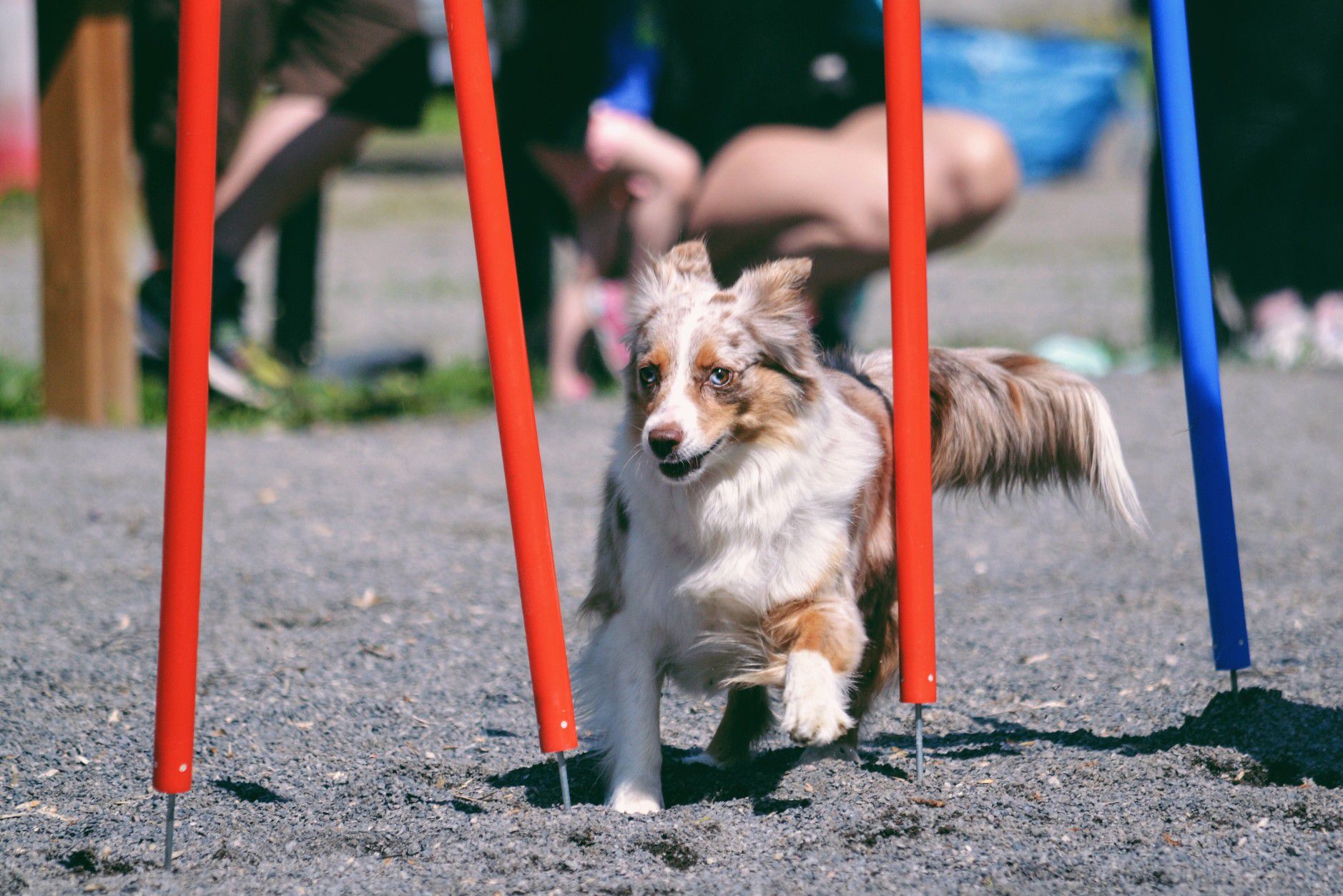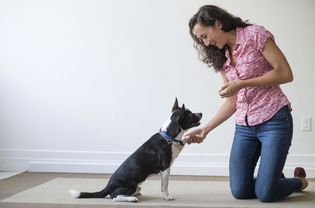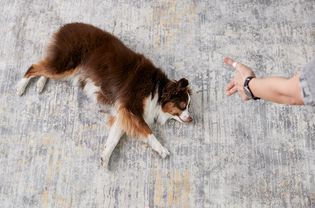Are you ready to start training your dog or puppy? Proper training and socialization are among your dog's basic needs. It's important to start training your dog as soon as possible to sit, stay, come, go to their crate, and go potty outside—and believe it or not, it's something you can do yourself as a beginner.
At first, dog training can seem pretty overwhelming, especially if this is your first dog. The truth is that training your dog is a very big project. If you take it step by step, you will find the task to be far less daunting. Here is some information to help get you started.
Dog Training Basics
- Start a dog obedience program. Learn how to set a basic foundation before you begin to train your dog. This will help establish consistent protocols you and your dog will follow, making it easier for everyone.
- Use positive reinforcement. Using positive reinforcement to train your dog means you reward the behaviors you like and ignore the behaviors you do not like. Rewards can be treats, playing with a toy, pets, or anything the dog responds to. These rewarding techniques can even be used to train fully potty-trained dogs to ring these clever doggy doorbells to let you know when they need to go relieve themselves.
- Make training fun. Why would you or your dog want to learn if neither one of you is enjoying the process? Keep training sessions short to prevent frustration, keep your tone light, and be fair to your dog. If you're both enjoying yourselves, your training sessions will be much more effective.
Watch Now: How to Train Your Dog With Positive Reinforcement
Housetraining and Crate Training
Unless you plan to keep your dog outdoors—and few pet owners do because it's not recommended—you'll need to teach your dog where to go potty. Therefore, housetraining (also called housebreaking or potty training) is one of the first things you need to work on with your dog. Crate training can be a very helpful part of the training process. This includes housetraining as well as many other areas of training:
- Crate training dogs and puppies: Here are the basics of training your dog or puppy to accept and even enjoy the crate. Not only will it help with housebreaking, but it will also give your dog a place of his own.
- How to housetrain your dog: When it comes down to it, housetraining is not that complicated, but this doesn't mean it's easy. Consistency and diligence are key during the housebreaking process.
- Submissive/excitement urination in dogs: If your dog is still having accidents in the house, it may be more than a simple housebreaking issue. Your dog might urinate out of excitement or to express submissive behavior.
Leash Training Dogs and Puppies
Every dog needs to learn to walk on a leash. Besides the fact that most areas have leash laws, there will be times when keeping your dog on a leash is for his own safety. Learn how to introduce your dog or puppy to a leash and a no-pull harness, then teach him how to walk properly on it, even beside you on a bike. A loose leash walk teaches your dog not to pull or lunge when on the leash, making the experience more enjoyable for both you and your dog.
:max_bytes(150000):strip_icc()/morning-walk-with-dog-black-labrador-retriever-young-man-is-training-his-puppy-walking-on-the-leash_t20_0AKxkw-b31317b825aa4bb3a5cae38cc994ba1b.jpg)
How to Socialize Dogs and Puppies
Socialization means training your puppy or adult dog to accept new people, animals, and various places by exposing him to these things. Socialized dogs are less likely to develop behavior problems and are generally more welcomed by others. Socialization can also help prevent the development of fears and phobias.
The bottom line is that socializing your dog or puppy will make him a happier, more well-behaved dog.
Clicker Training for Dogs
Clicker training, a common form of positive reinforcement, is a simple and effective dog training method. Although it is still fine to train your dog without clicker training, many people find it helpful. With clicker training, you can easily and effectively teach your dog all kinds of basic and advanced commands and tricks. It's fast and easy to learn how to clicker train your dog.
Basic Commands and Fun Tricks
There are some basic dog training commands and dog tricks that every dog should know like come, speak, drop it, stay, back up, and more. Basic commands give your dog structure. In addition, they can help you overcome common dog behavior problems and will help keep your dog safe.
How to Train Your Dog to Stay
What's more fun than showing off your dog's cool tricks? Once you master the basics, tricks are a great way to take your dog training to the next level and give your dog some mental stimulation.
Proofing Behaviors and Troubleshooting
Proofing is the last step in training your dog to do any new behavior. Learn how to proof behaviors so your dog will be as obedient at the park or a friend's house as he is in your own living room.
Remember, just because you have reached the final stages of training, it doesn't mean that behavior problems won't crop up. Learn about the most common dog behavior problems and how to deal with them. These guides will help you navigate this part of the training process:
- Practice, practice, practice. Practice behaviors in a variety of places with different levels of distraction. Without proofing, your dog may behave well in your living room but seems to forget all his training when he is outside the house.
- Recognize common dog behavior problems. Understanding potential behavior issues can help you detect and address them before things get out of control.
Advanced Dog Training
Once your dog has mastered all the basics, you can consider moving on to more advanced tricks or training your dog to do dog sports. These activities will help keep your dog active, fit, and mentally stimulated. Plus, they will help strengthen the bond you share with your canine companion.
Remember that training is an ongoing process. You will never be completely finished. It is important to keep working on obedience training throughout the life of your dog. People who learn a language at a young age but stop speaking that language may forget much of it as they grow older. The same goes for your dog: Use it or lose it. Running through even the most basic tricks and commands will help them stay fresh in your dog's mind. Plus, it's a great way to spend time with your dog.
-
How many hours a day should you train your dog?
Short dog training sessions are best to ensure he won’t feel overwhelmed, irritated, disinterested, or bored. Even just a few minutes at a time can make a difference. You don’t need to train your dog for an hour or more daily to get results; instead, you can move through several short training sessions throughout the day, monitoring your dog’s reactions to figure out when he’s had enough.
-
How do you train your dog to ignore other dogs?
While your dog should always be leashed when out, there are other ways to train him to be unbothered by other dogs while on walks. Keep a distance from other dogs while out and call your dog's name whenever he notices another dog, rewarding them with a treat. You can continue this process, gradually getting a little closer to dogs while encouraging your pup to ignore them and rewarding him with a treat.
-
How do you train your dog not to run away?
Many experts believe that chasing a dog that is running away will only encourage him to run further because the dog thinks this is a game. Start training your dog to stay with you by slowly walking away from him, then calling his name and rewarding him with a treat when he comes to you. You can even add to this training by spending time with friends, having them call your dog, and giving him a treat when he comes to them.
-
How do you train your dog not to jump on people?
Start by asking your dog to "sit," and asking people not to approach. If your dog is approached and obeys this command, offer him a treat. Reinforcement is key!

:max_bytes(150000):strip_icc()/jenna-stregowski-tsp-bio-page-300fa370d15f4fb1ae407340bb7ea3ae.png)
:max_bytes(150000):strip_icc()/Steps-to-train-your-dog-1118273-7f3a74792b15472bb0d1f4884bd95875.jpg)







